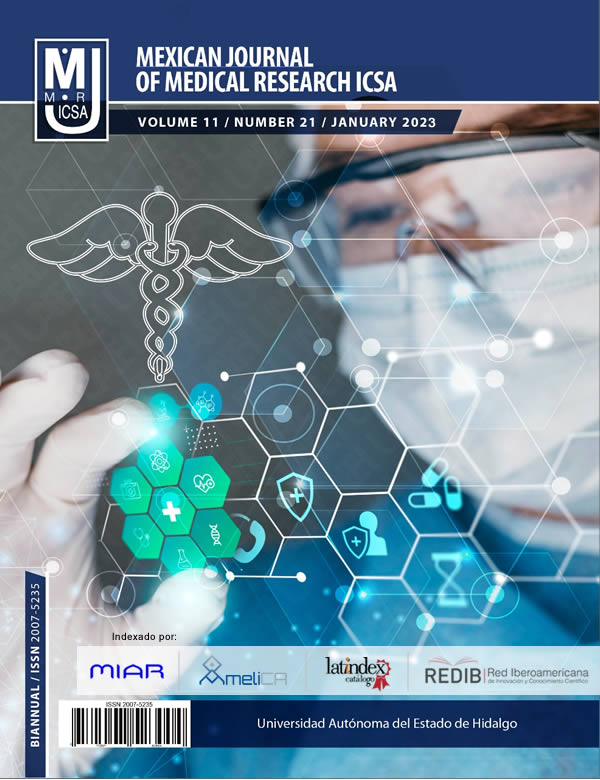Self-medication in ophthalmologic problems. What is known about it?
DOI:
https://doi.org/10.29057/mjmr.v11i21.10079Keywords:
Self-medication, ophthalmology, conventional medicine, alternative and complementary medicineAbstract
Self-medication (SM) refers to any practice for curative purposes that is not prescribed by a physician. It includes the use of conventional or allopathic medicine (CM) and complementary and alternative medicine (CAM). In the case of ophthalmologic ailments, this division can also be seen, within CM, the use of anesthetics, analgesics and topical antibiotics, for the treatment of mainly traumatic pathologies, to save time and money, advised by their close circle, but always with the risk of not improving, abusing the medication, producing toxicity, masking the condition and giving an incorrect treatment. CAM highlights the use of biological therapies due to the variety of products that have been documented, such as chamomile, tea leaves, garlic, sage, etc. But also the use of mind-body therapies, manipulative and body-based methods; and energy therapies such as acupuncture; there are many more pathologies for which they are used compared to CM, and they resort to it precisely because of the lack of results of CM, the sources of information are usually similar and although they seem harmless, they are not innocuous. In general, it is a subject that is little addressed, but is relevant due to the risks involved. This manuscript seeks to provide an overview so that medical personnel remain expectant and in each intervention detect the areas of opportunity that reduce this practice.
Downloads
Publication Facts
Reviewer profiles N/A
Author statements
- Academic society
- N/A
- Publisher
- Universidad Autónoma del Estado de Hidalgo
References
Montastruc J, Bondon-Guitton E, Abadie D, et al. Pharmacovigilance, risks and adverse effects of self medication. Therapie. 2016; 71(2): 257-262.
Caamaño F, Figueiras A, Lado-Lema E, Gestal-Otero JJ. La automedicación: concepto y perfil de sus “usuarios”. Gac. Sanit. 2000; 14(4): 294-9.
World Health Organization. Guidelines for the regulatory assessment of medicinal products for use in self-medication. WHO Drug Inf. 2000; 14(1): 18-26.
Food and Drug Administration. Guidance for Industry on Complementary and Alternative Medicine Products and Their Regulation by the Food and Drug Administration. Silver Spring, MD: Food and Drug Administration. 2006.
Ortiz MI, Flores-Ceron KI, Muñoz-Pérez VM. Self-medication practice in Mexico. Sr. Care Pharm. 2022; 37(7): 266-83.
Tavares AI. Substitutes or complements? Diagnosis and treatment with non-conventional and conventional medicine. Int. J. Health Policy Manag. 2015; 4(4): 235-42.
Kotsirilos V. Complementary and alternative medicine. Part 1--what does it all mean? Aust. Fam. Physician. 2005 Jul; 34(7): 595-7.
Sharifi A, Sharifi H, Karamouzian M, Mokhtari M, Esmaeili HH, Nejad AS, Rahmatian M. Topical ocular anesthetic abuse among Iranian welders: time for action. Middle East. Afr. J. Ophthalmol. 2013; 20(4): 336-40.
Sughra U, Khan WA, Kausar S. Topical Ocular Anesthetic Use among Welders of Rawalpindi City, Pakistan. J. Coll. Physicians Surg. Pak. 2021; 30(6): 737-739.
Yagci A, Bozkurt B, Egrilmez S, Palamar M, Ozturk BT, Pekel H. Topical anesthetic abuse keratopathy: a commonly overlooked health care problem. Cornea. 2011; 30(5): 571-5.
Leon-Hernandez FA, Luque-Arellano M, Torres-García FJ, Borges-Trujillo RA, Valls de Quintana P, Ventura-Rodríguez A. Automedicación en patología oftálmica de urgencias comunicación presentada en la XVIII Reunión de la Sociedad Canaria de Oftalmología. 1992; 21(2): 59-64.
Castillo-Picado WM, Morales-Palacios IM, Nicaragua-Corea MJ. Automedicación con dexametasona oftálmica en personas de 18 a 65 años que se encontraban en la sala de espera de consulta externa del Centro Nacional de Oftalmología (CENAO) en el período de Noviembre 2011. Nicaragua: UNAN; 2012.
Wu H, Hu Y, Shi XR, Xu F, Jiang CY, Huang R, Jia H. Keratopathy due to ophthalmic drug abuse with corneal melting and perforation presenting as Mooren-like ulcer: A case report Exp. Ther. Med. 2016; 12(1): 343-346.
Khakshoor H, Moshirfar M, Simpson RG, Gharaee H, Vejdani AH, Christiansen SM, Edmonds JN, Behunin NL. Anesthetic keratopathy presenting as bilateral Mooren-like ulcers. Clin. Ophthalmol. 2012; 6: 1719-22.
Erdem E, Undar IH, Esen E, Yar K, Yagmur M, Ersoz R. Topical anesthetic eye drops abuse: are we aware of the danger? Cutan. Ocul. Toxicol. 2013; 32(3): 189-93.
Mahjoub H, Prabhu AV, Sikder S. What are Ophthalmology Patients Asking Online? An Analysis of the Eye Triage Subreddit. Clin. Ophthalmol. 2020; 14: 3575-3582.
McGee HT, Fraunfelder FW. Toxicities of topical ophthalmic anesthetics. Expert Opin. Drug Saf. 2007; 6(6): 637-40.
Katsimpris JM, Sarantoulakou M, Kordelou A, Petkou D, Petropoulos IK. Clinical findings in patients with topical anaesthetic abuse keratitis: a report of five cases. Klin. Monbl. Augenheilkd. 2007; 224(4): 303-8.
Ardjomand N, Faschinger C, Haller-Schober EM, Scarpatetti M, Faulborn J. Nekrotisierende ulzerierende Keratopathie nach Lokalanästhetikamissbrauch Ein klinisch-pathologischer Fallbericht [A clinico-pathological case report of necrotizing ulcerating keratopathy due to topical anaesthetic abuse]. Ophthalmologe. 2002; 99(11): 872-5.
Matti AI, Saha N. Topical ocular anaesthetic abuse in a contact lens wearer: a case of microbial keratitis. Clin. Exp. Optom. 2012; 95(6): 653-4.
Kurna SA, Sengor T, Aki S, Agirman Y. Ring keratitis due to topical anaesthetic abuse in a contact lens wearer. Clin. Exp. Optom. 2012; 95(4): 457-9.
Patel M, Fraunfelder FW. Toxicity of topical ophthalmic anesthetics. Expert Opin. Drug Metab. Toxicol. 2013; 9(8): 983-8.
Penna EP, Tabbara KF. Oxybuprocaine keratopathy: a preventable disease. Br. J. Ophthalmol. 1986; 70(3): 202-4.
AlSalman S, AlHussaini MA, Khandekar RB, Edward DP. The Proportion of Complementary and Alternative Medicine Utilization Among Saudi Population for Eye Care: Cross-Sectional Study. Cureus. 2021; 13(2): e13109.
Smith JR, Spurrier NJ, Martin JT, Rosenbaum JT. Prevalent use of complementary and alternative medicine by patients with inflammatory eye disease. Ocul. Immunol. Inflamm. 2004; 12(3): 203-14.
Jaber D, Ghannam RA, Rashed W, Shehadeh M, Zyoud SH. Use of complementary and alternative therapies by patients with eye diseases: a hospital-based cross-sectional study from Palestine. BMC Complement Med. Ther. 2021; 21(1): 3.
Bhartiya S, Ichhpujani P. Complementary and Alternate Management of Glaucoma: The Verdict so Far. J. Curr. Glaucoma Pract. 2014; 8(2): 54-7.






















